You may want to disable Edge updates to make it stick to some specific browser version. By default the app fetches most recent versions from the Internet, and installs them in the background.
Advertisеment
This behavior is default to most Chromium-based browsers. Google Chrome, Opera - most modern browsers install updates silently. Also, most of them do not provide the user with an easy-to-use option to disable the updates.
Edge is not an exception here. If you go through its settings, you will not find an option to prevent it from updating.
The official way are Group Policies that Microsoft provides. Sadly, they only works in an Enterprise environment, and don't support consumer instances.
For consumers, the only way to stop updates in the Edge browser is to prevent its updater, the EdgeUpdate app, from accessing the Internet. For that, you need no extra tools, the built-in Windows Firewall will do the trick.
Disable Edge Updates
- Run the Registry editor (Win +R > regedit).

- Navigate to the following branch:
HKEY_LOCAL_MACHINE\SYSTEM\CurrentControlSet\Services\edgeupdate.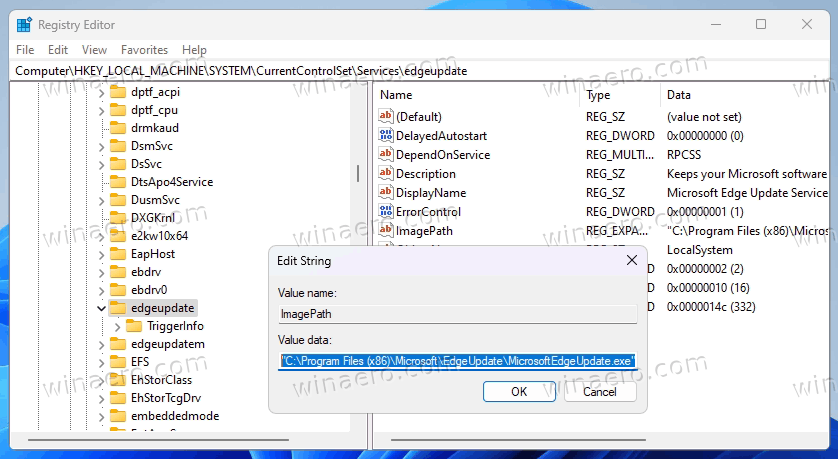
- Check out the ImagePath value to find the path to the MicrosoftEdgeUpdate.exe file.
- Open Terminal as Administrator (Win + X > Terminal(Admin)).
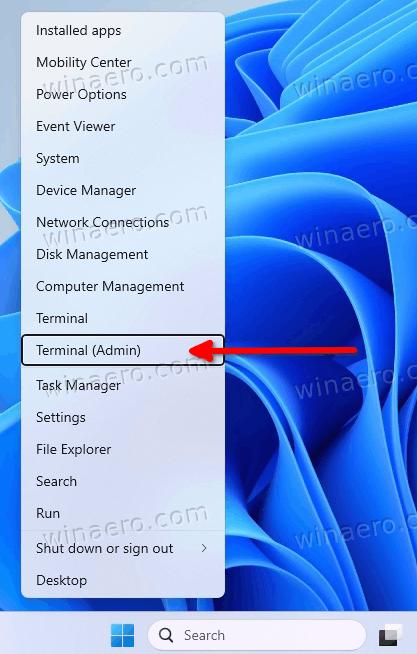
- Type the following command:
netsh advfirewall firewall add rule name="Disable Edge Updates" dir=out action=block program="C:\Program Files (x86)\Microsoft\EdgeUpdate\MicrosoftEdgeUpdate.exe". Correct the path to the MicrosoftEdgeUpdate.exe file according to the path you found in the step 3.
You are done. Edge will no longer download and install updates, all its channels. As result, the edge://settings/help page will show an error.
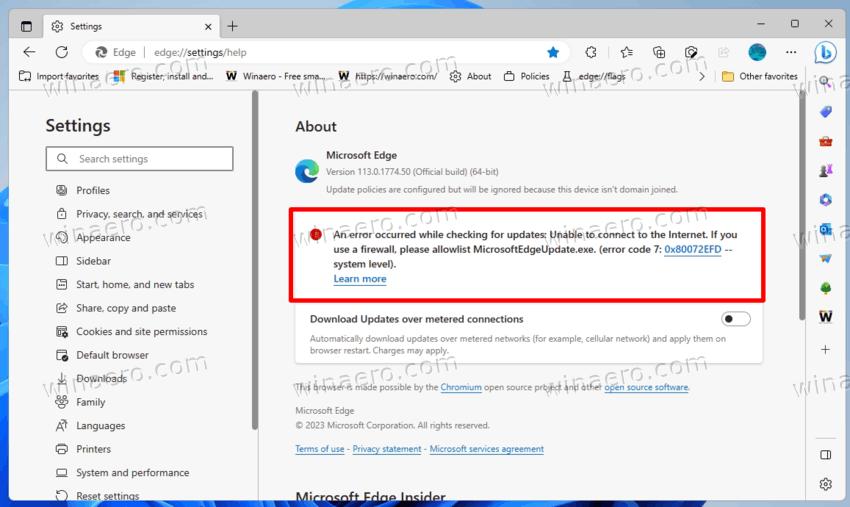
How it works
All channels of Microsoft Edge use the same updater app. It runs as a Windows service, and downloads new browser versions in the background.
With the reviewed netsh command you create a firewall rule to stop outbound traffic for the EdgeUpdate app. It will prevent it from connecting to the Internet, and downloading anything.
If you open the edge://settings/help page in your browser, it will clearly state that it is unable to get new versions due to an issue with EdgeUpdate. You will see the following error message:
An error occurred while checking for updates: Unable to connect to the Internet. If you use a firewall, please allowlist MicrosoftEdgeUpdate.exe. (error code 7: 0x80072EFD -- system level).
Re-enable updates
The reviewed method is safe and easy to undo. All you need to do is to delete the Firewall rule. For example, you can issue the following netsh command to remove it.
netsh.exe advfirewall firewall delete rule name="Disable Edge Updates" program="C:\Program Files (x86)\Microsoft\EdgeUpdate\MicrosoftEdgeUpdate.exe".

Don't forget that you need to run the above command in a Terminal or Command Prompt open as Administrator.
Using Winaero Tweaker
Winaero Tweaker includes an easy-to-use option to stop Edge from receiving updates. All you need to do is to tick the checkbox, and Edge will no longer install new versions.
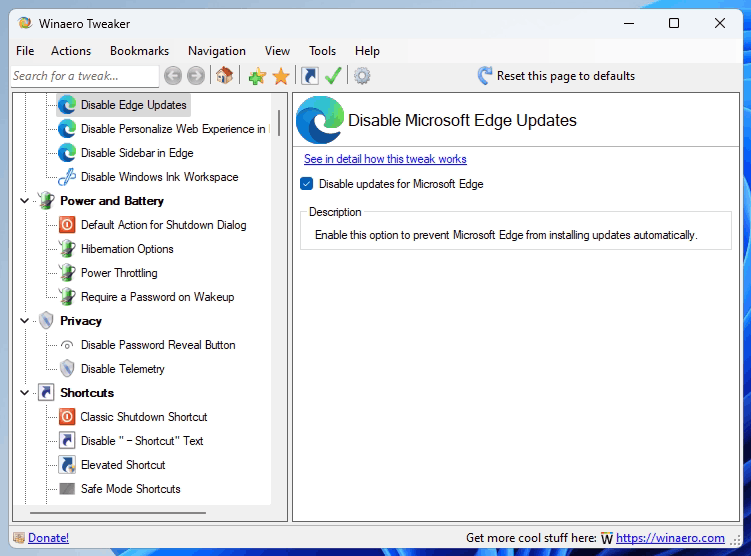
You can get the Winaero Tweaker app here.
If you are not happy with the Registry editing, you can do everything using the GUI, or combine the two methods. Here's how to stop Edge from getting updates using the built-in apps with the friendly user interface, Firewall and Services.
Stop Edge from installing updates with built-in Firewall
- In Search, type services, and press Enter to open the eponymous app.
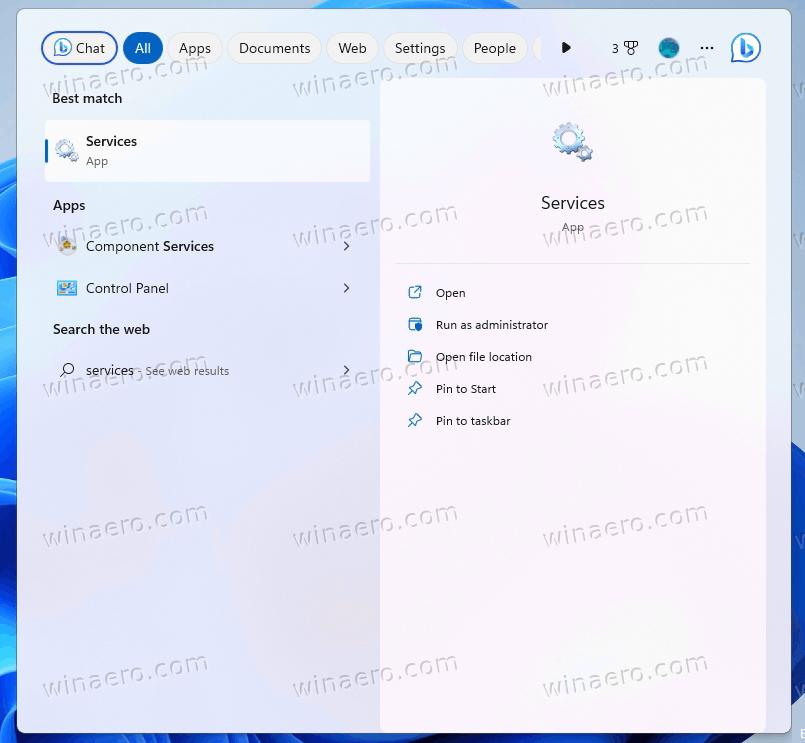
- Find the "Microsoft Edge Update Service (edgeupdate)" service and double-click it to open its properties.
- Copy the path to the MicrosoftEdgeUpdate.exe file, i.e. select it and press Ctrl + C.
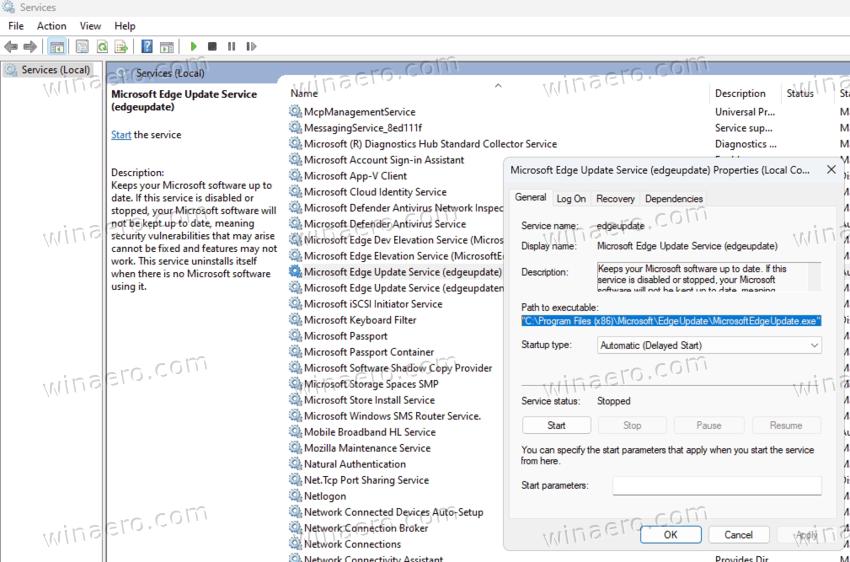
- Now, return back to search, and type firewall. Pick the "Windows Firewall with Advanced Security" item.
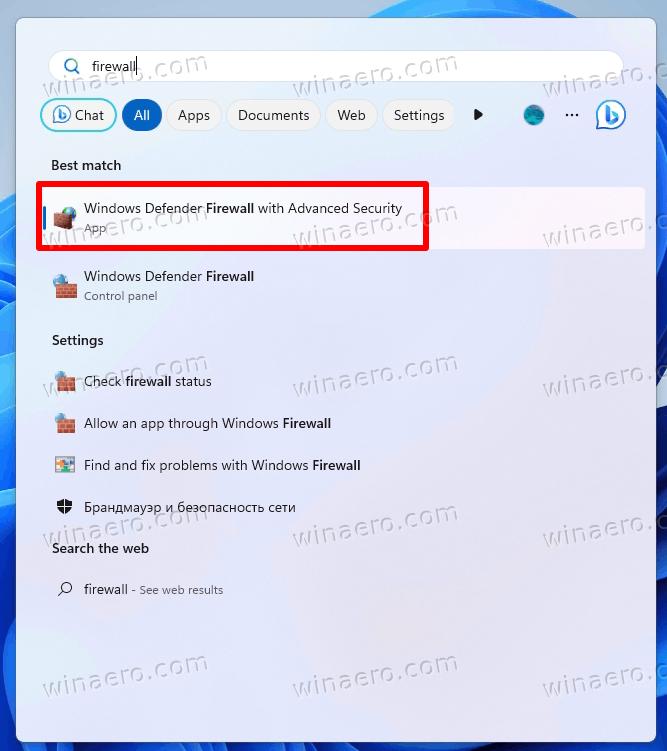
- In Windows Firewall, click on Outbound Rules on the left.
- In the rightmost pane, click New rule.

- On the new rule wizard page, select Program, and click Next.
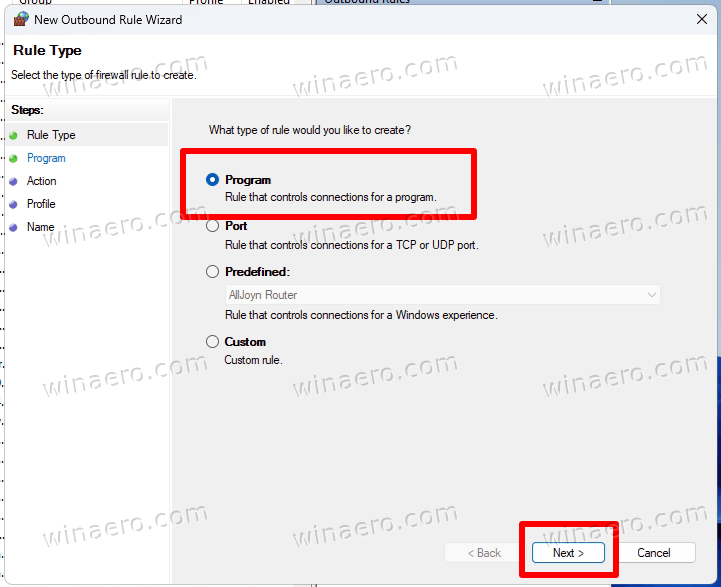
- On the Program page, paste the path you copied earlier, e.g.
C:\Program Files (x86)\Microsoft\EdgeUpdate\MicrosoftEdgeUpdate.exe, and click Next. Note: Remove quotes from the path.
- On the action page, select Block.
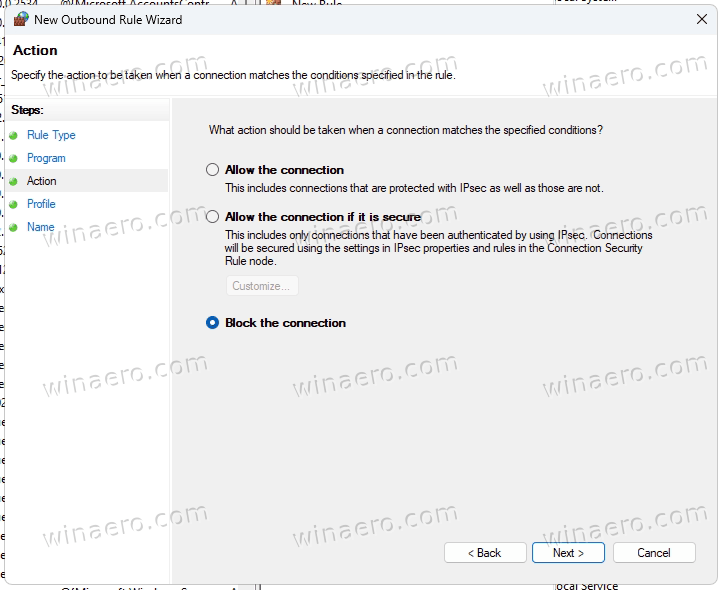
- For the profile page, select all the Network type profiles to block MicrosoftEdgeUpdate in all networks.
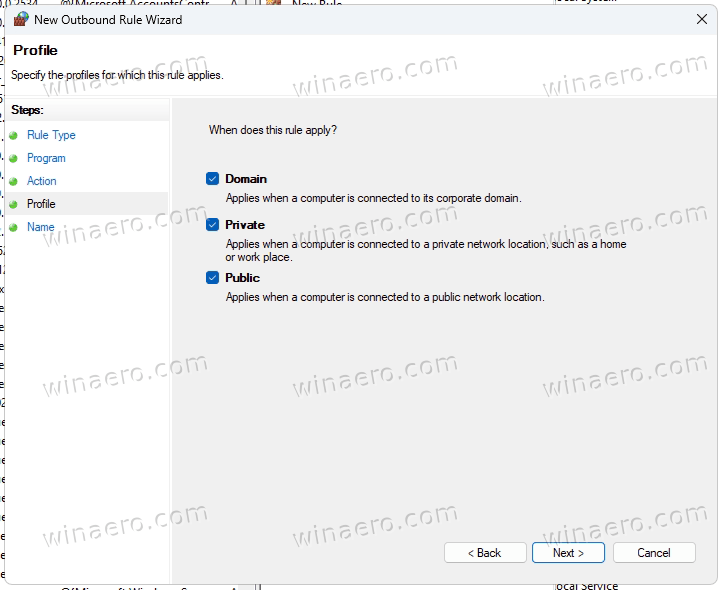
- The only step you need to get is to fill in the Firewall rule name. Type something like "Block Edge Updates", click Finish, and you are done!
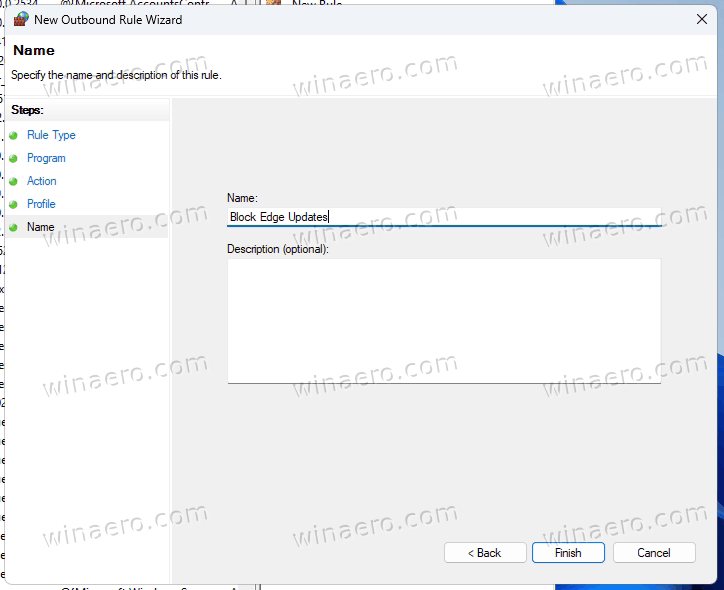
It is easy to undo the change by removing your rule from the Firewall. Just find it in the list of rules, right-click and select Delete from the menu.
The changes take effect immediately.
Now, lets review options that AD/AAD users have.
Turn off Updates in Microsoft Edge with Group Policy
Note: The group policy method only works in Enterprise environment. Your device must be enrolled into Active Directory, or AAD. The Group Policy apply to the EdgeUpdate app, which ignores them on consumer devices.
Edge allows you disabling updates for all release channels individually, i.e. for Canary, Dev, Beta, and Stable. This adds some configuration flexibility for users who have multiple app releases installed simultaneously. Depending on what you are going to achieve, you can go with the following scenarios.
- Turn off updates for all channels by default, enable updates only for a specific channel(s), say for Canary.
- Turn off updates for individual release channels, e.g. for Stable, so the rest will receive new versions as usual.
Do the following.
Disable updates in Microsoft Edge for all channels
- Open the Registry Editor app; for that, press Win + R and type regedit in the Run dialog.
- Now, navigate to the following branch: HKEY_LOCAL_MACHINE\SOFTWARE\Policies\Microsoft.
- Right-click the Microsoft subkey in the left pane, and select New > Subkey.
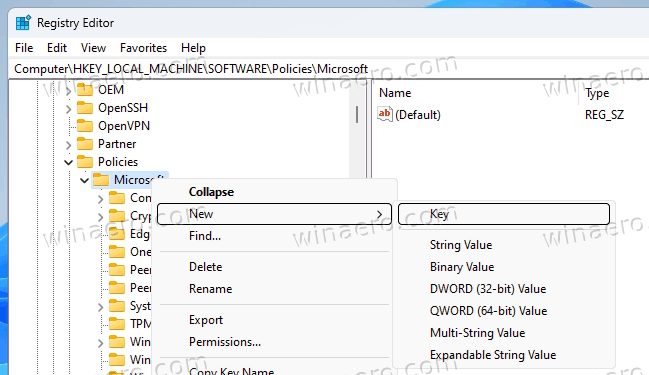
- Name the new key EdgeUpdate.
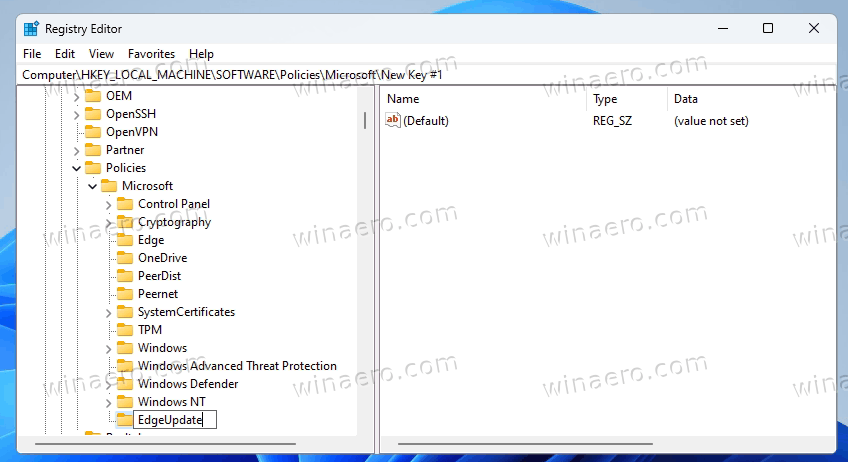
- Now, right-click the EdgeUpdate key. This time select New > DWORD (32-bit) value. Name it UpdateDefault.

- To disable Edge updates, leave the UpdateDefault value data as 0.
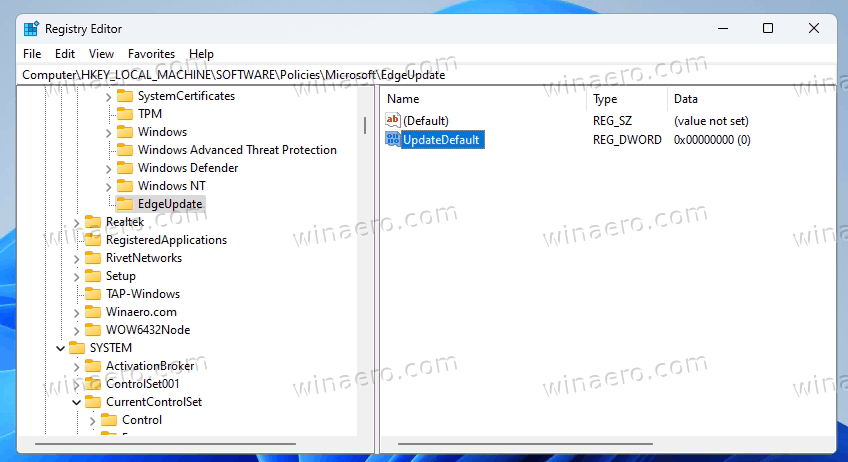
- Now, open a new tab in Microsoft Edge, and type
edge://policiesin the URL box. - Click on the Reload button to apply the changes.
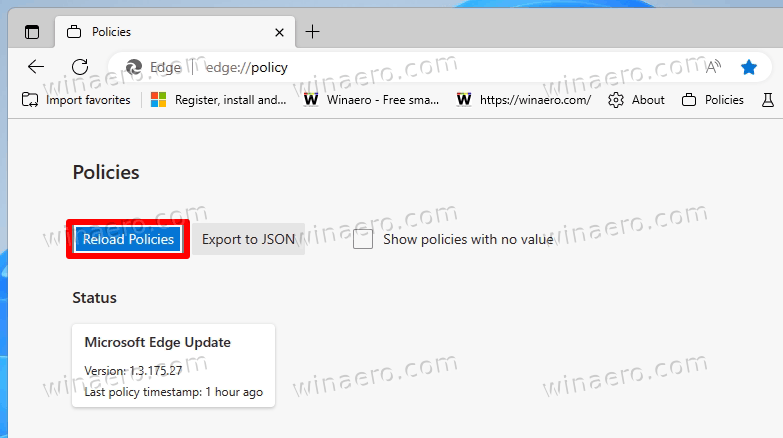
Congrats, you have successfully disabled updates for Microsoft Edge.
So, UpdateDefault affects all the installed Edge versions, from Stable to Canary, unless you specify the exception. It is worth noting that it supports several over values that you can use.
UpdateDefault supported values
- UpdateDefault = 1 - Always allow updates. This is the default value.
- UpdateDefault = 2 - Manual updates only. The user has to runs a manual update check to install them.
- UpdateDefault = 3 -Automatic silent updates only. Edge will install updates without notifying the user.
- UpdateDefault = 0 - Disables the updates from being downloaded and installed.
Block updates for specific channels
Navigate to the HKEY_LOCAL_MACHINE\SOFTWARE\Policies\Microsoft\EdgeUpdate key. If the EdgeUpdate subkey is missing, then create it manually.
Now, create one or more of the following DWORD values, depending on what channel you want to disable updates for.
- Stable: Update{56EB18F8-B008-4CBD-B6D2-8C97FE7E9062}
- Beta: Update{2CD8A007-E189-409D-A2C8-9AF4EF3C72AA}
- Canary: Update{65C35B14-6C1D-4122-AC46-7148CC9D6497}
- Dev: Update{0D50BFEC-CD6A-4F9A-964C-C7416E3ACB10}
Keep the value data as 0 (zero) for all the values you have created.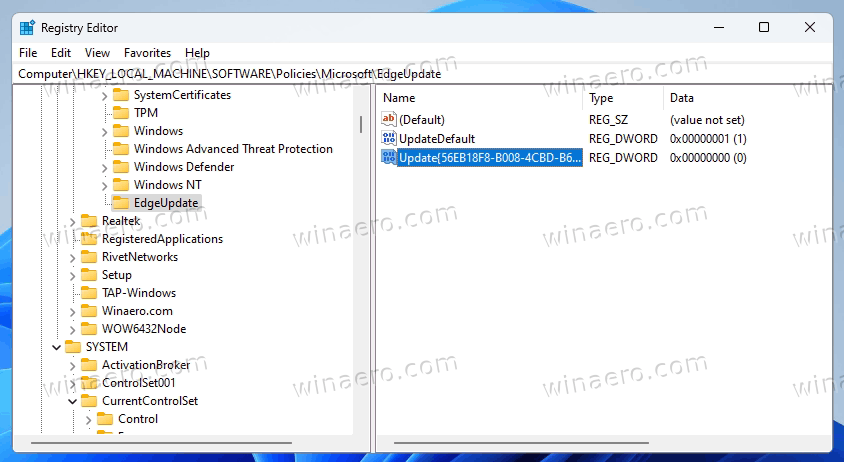
If the values have no effect, try creating the above reviewed UpdateDefault value and setting it to 1.
Keep updates only for specific channels
By using the reviewed policies, it is easy to create an allow list for release channels that will receive new versions, while others won't. You can do it as follows.
- Under the Registry key HKEY_LOCAL_MACHINE\SOFTWARE\Policies\Microsoft\EdgeUpdate create the UpdateDefault value and keep its data as 0. This will stop updates for all Edge channels.
- Under the same key, create one or more of the following values. By setting these to 1, you will permit updates for the specific channel.
- Stable: Update{56EB18F8-B008-4CBD-B6D2-8C97FE7E9062}
- Beta: Update{2CD8A007-E189-409D-A2C8-9AF4EF3C72AA}
- Canary: Update{65C35B14-6C1D-4122-AC46-7148CC9D6497}
- Dev: Update{0D50BFEC-CD6A-4F9A-964C-C7416E3ACB10}
- Finally, you will end up with something like the Registry screenshot below that permits Edge Canary and Stable updates, but stops updates for Dev and Beta.

That's it!
Support us
Winaero greatly relies on your support. You can help the site keep bringing you interesting and useful content and software by using these options:
If you like this article, please share it using the buttons below. It won't take a lot from you, but it will help us grow. Thanks for your support!
Advertisеment

This is what I did:
1. Disabled Microsoft Edge Update Service (both edgeupdate and edgeupdatem) in services.msc
2. Deleted the Edge Update scheduled tasks (You can move them anywhere you want from C:\Windows\System32\Tasks). They’re simply unnecessary, Edge will try to update without them anyway.
3. Then renamed MicrosoftEdgeUpdate.exe to something else (Usually in Program Files (x86), but search for the file because the stupid dir structure is unpredictable, I have no idea where will they move it in the future)
REVERT? Re-enable tasks in services.msc, rename back the MicrosoftEdgeUpdate.exe.
Notice that it will try to check for updates upon the launch of Edge (in the background), but will error-out and not bother you. So far it works for me.
I need to mention that after some long time, on other chromium browsers, I used to get a notification next to the profile icon that there’s an error. I’ve no clue how long has passed since I disabled Brave update, but it was long enough that I wanted to manually update it myself.
The biggest gripe I’ve got against these updates is that not only can they break shit, but also can be used as a pretense to push something rogue (a sniffing mechanism) by the update party, install a pesky function that horribly annoys users to pay for options which were originally free (legal mafia really), or simply let the company have their way on user equipment. I also don’t understand why people sheepishly subscribe to the idea that this stuff is OK. That pushing updates is justifiable because companies decided that people’s free will is incorrect and they have no right in making the decision themselves.